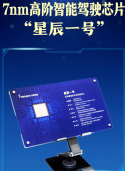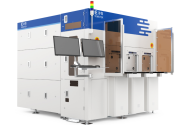Do 14nm or 16nm process build chips with over 30B transistors?This seems related to chips with 30 billion transistors or more.
US bans sales of 14nm and 16nm chips with over 30 billion transistors to China
Mainly US administration forces Chinese design companies that use TSMC for manufacturing to also use approved OSAT (i.e. American ones) for packaging.
It seems a kind of blackmail: "if you want to use TSMC, then you have to use US OSAT".
This will definitely have an impact in the short term, let's say in 2025. I'm thinking for instance at the new ADAS chips for autonomous driving. I don't know if Horizon Robotics, Black Sesame and the others use TSMC foundry services. If this is the case, they will surely have an impact....maybe not an unexpected one though, considering that ADAS chips are a kind of AI chips and that tran ADAS market will be a huge thing in the next 1/2 years. Currently the incumbent is NVIDIA, but of course Chinese automotive companies cannot rely on NVIDIA.
From China POW the only way out is for SMIC to grow capacity in the advanced nodes.
Recently there have been rumors of SMIC starting a price war in the 28nm node, it is a sign of good free capacity there. They should urgently move that capacity down to 14/16. Where "urgently" means within end of 2025. I don't know if it is technically feasible, apparently the main Chinese SME vendors are already there...with the big question mark on SMEE.
Unfortunately SMEE proves itself once again the weak link in the supply chain. The SMEE train keeps running 2 years behind schedule. This is proving painful once again.
The delay of SMEE was accumulated all before 2019, when at SMEE the old management was allowed to fake litho machines prototypes paid with government money. At the time ASML supply was considered eternal and bullet proof. A serious oversight that China is still paying today.
You are using an out of date browser. It may not display this or other websites correctly.
You should upgrade or use an alternative browser.
You should upgrade or use an alternative browser.
Chinese semiconductor thread II
- Thread starter vincent
- Start date
Chinese firms still buying large number of DUV's from ASML.. so they can expand 14nm/16nm with rest tools from Chinese companies. all Non-litho tools are completed and entered in production. i don't see any big issue in this expansion..
that Optics Valley conference in summer 2024, they confirmed DUVi.. completed , tested and debugged.. all critical steps have passed so what's stopped SMEE to announce or at least give some hint.. you also post the pic of SSA800i scanner..
I think ASML DUVi is now banned in China
exports of DUV immersion lithography systems to these specific locations could also be affected
Regarding Optic Valley conference and the pic of SSA800i scanner, it was expressly labeled for 28nm, not 14/16nm.
Of course DUVi is needed also for 28nm, but for 14/16 you need a better machine, with stricter overlay tolerances. As of today I have read no info on SMEE to be at 14/16nm.
just look at this pattern..Of course DUVi is needed also for 28nm, but for 14/16 you need a better machine, with stricter overlay tolerances. As of today I have read no info on SMEE to be at 14/16nm.
SMEE released 7nm capable Overlay Metrology tool in 2024.
SMEE released high end optical defect inspection tool last month.
SMEE won the bidding for 4 After Developing Inspection (ADI) tools. SMEE made this tools to go along their lithography tools. they said that their overlay tools can be used till a 7nm process. Overlay tools are couple with Lithography Machines and the Lithography process to "fine tune" the lithography machine in order to pattern the next layer..
----------------------------------------------------------------------------------------------
SMEE don't work alone in R&D.. they have collaboration with CAS and other top institutes..
CAS and SMEE has solved the overlay problem in China with grating systems and new mark system, from now on ALL SMEE machines will have superior enhanced performance and precision.

--------------------------------------------------------------------------------------------------
there is one more very critical component for 14nm and below..
U-Precision completed more precise next gen grating interferometers for EUV scanners and immersion scanners for below 14nm nodes, sub-nanometer accuracy..


with all these developments, looks like SMEE SSA800i targeting 14nm and below..
just look at this pattern..
SMEE released 7nm capable Overlay Metrology tool in 2024.
SMEE released high end optical defect inspection tool last month.
SMEE won the bidding for 4 After Developing Inspection (ADI) tools. SMEE made this tools to go along their lithography tools. they said that their overlay tools can be used till a 7nm process. Overlay tools are couple with Lithography Machines and the Lithography process to "fine tune" the lithography machine in order to pattern the next layer..
----------------------------------------------------------------------------------------------
SMEE don't work alone in R&D.. they have collaboration with CAS and other top institutes..
CAS and SMEE has solved the overlay problem in China with grating systems and new mark system, from now on ALL SMEE machines will have superior enhanced performance and precision.
View attachment 145246
--------------------------------------------------------------------------------------------------
there is one more very critical component for 14nm and below..
U-Precision completed more precise next gen grating interferometers for EUV scanners and immersion scanners for below 14nm nodes, sub-nanometer accuracy..
View attachment 145247
View attachment 145248
with all these developments, looks like SMEE SSA800i targeting 14nm and below..
There is no point in this case saying they are targeting 14nm and below. The machines will only be used in those processes once a fab has validated them for those nodes.
I think it's important for us to not over state SMEE's current status. We simply don't know for sure if it's DUVi machines are in HVM with SMIC or one of the other major fabs. And even if it is being used for 40nm or 28nm, it will still take time to be validated for more advanced nodes.
I've said this a while ago, They have all the ASML machines they need to increase capacity at SMSC plants to 70k wpm. so 7-14nm capacity was more about other equipment.
Well this is when "foreign is better" has come to haunt everyone, semiconductor fab managers, SMIC, HHgrace and others in China have a lot of the blame, semiconductor equipment is not develop in a vacuum, fabs play a big role there too and there was no reason no to push SMEE dry scanners to become better, especially when everyone knew that risk of export controls. The government should also had to push for SMEE more aggressively given the China has always been at the risk of sanctions and export controls. China shouldn't have allowed ASML to monopolize at least the KrF and I-Line market, that segment should had been exclusive for China lithography companies.This seems related to chips with 30 billion transistors or more.
US bans sales of 14nm and 16nm chips with over 30 billion transistors to China
Mainly US administration forces Chinese design companies that use TSMC for manufacturing to also use approved OSAT (i.e. American ones) for packaging.
It seems a kind of blackmail: "if you want to use TSMC, then you have to use US OSAT".
This will definitely have an impact in the short term, let's say in 2025. I'm thinking for instance at the new ADAS chips for autonomous driving. I don't know if Horizon Robotics, Black Sesame and the others use TSMC foundry services. If this is the case, they will surely have an impact....maybe not an unexpected one though, considering that ADAS chips are a kind of AI chips and that ADAS market will be a huge thing in the next 1/2 years. Currently the incumbent is NVIDIA, but of course Chinese automotive companies cannot rely on NVIDIA.
From China POW the only way out is for SMIC to grow capacity in the advanced nodes.
Recently there have been rumors of SMIC starting a price war in the 28nm node, it is a sign of good free capacity there. They should urgently move that capacity down to 14/16. Where "urgently" means within end of 2025. I don't know if it is technically feasible, apparently the main Chinese SME vendors are already there...with the big question mark on SMEE.
Unfortunately SMEE proves itself once again the weak link in the supply chain. The SMEE train keeps running 2 years behind schedule. This is proving painful once again.
The delay of SMEE was accumulated all before 2019, when at SMEE the old management was allowed to fake litho machines prototypes paid with government money. At the time ASML supply was considered eternal and bullet proof. A serious oversight that China is still paying today.
But the lessons have been learned the hard way. Looks like SMEE scanners are already working, let see if fab managers want to make advanced chips or they want to keep making toaster chips for eternity
Also the DeepSeek saga show everyone that you don't have to things like everyone else do, you can do things differently, why the EUV light source has to be LPP? because ASML did it? why not Discharge Produced Plasma or Laser Discharge Plasma? Why not push harder for SSMB? Why EUV at all? China has 5 really good Nanoimprint lithography companies, one of the already displaced Nikon tools in LED production, why not create between the ICRD, SMIC, the government and equipment a pilot research line to accelerate the development of this technology for chip production, does Chinese companies need wait for Canon to achieve a breakthrough? I don't think has to be that way.

Two products from Wuhan Economic and Technological Development Zone were selected as the top ten science and technology innovation products in Wuhan in 2024.
On February 6, Wuhan held the "first meeting" of the Year of the Snake - the city's science and technology innovation conference. Liu Ziqing, member of the Standing Committee of the Municipal Party Committee and Secretary of the Wuhan Economic Development Zone Working Committee, delivered a keynote speech at the meeting, introducing the effective path for Wuhan Economic Development Zone to empower industrial transformation with scientific and technological innovation and its measures to promote the integration and innovation of industry and technology. The conference also released the top ten science and technology innovation products in Wuhan in 2024 through video, and two car valley science and technology innovation products, Xintao Technology's electrostatic chuck and Xinqing Technology's 7-nanometer high-end intelligent driving chip "Xingchen No. 1", were selected.


Electrostatic chucks are the core components of a series of key equipment in the chip manufacturing process. Domestic electrostatic chucks are related to the security and stability of the chip industry chain. Hubei Xintao Technology Co., Ltd. has mastered the core raw materials such as high-purity ultra-fine alumina powder, ordered phase porous ceramics, bonding glue, and key process technologies such as electrostatic chuck degassing, sintering, and coating, and has developed a number of extremely difficult electrostatic chucks for chip manufacturing, breaking the foreign monopoly and achieving independent control of electrostatic chucks for chip manufacturing.
High-end autonomous driving chips are the core components of intelligent driving systems. In October 2024, the 7-nanometer high-end intelligent driving chip "Xingchen No. 1" independently developed by CoreEngine Technology was successfully lit up and completed verification testing. It will be mass-produced in 2025 and put into large-scale automotive applications in 2026. The chip adopts 7-nanometer automotive-grade process and multi-core heterogeneous architecture, with AI computing power of 512 TOPS and functional safety level reaching ASIL-D level. It supports the computing power requirements of L2-L4 level autonomous driving full-scenario applications, filling the gap of domestic autonomous driving chips of this computing power level.
In recent years, Wuhan Economic and Technological Development Zone has insisted on writing innovation on the banner of development. Starting from the urgent needs of industrial development, it has fully supported the collaborative innovation between enterprises and universities, independent innovation of enterprises above designated size, and integrated innovation of large, medium and small enterprises, and actively explored effective ways to empower industrial transformation with scientific and technological innovation.
Completed nearly 100 million yuan in financing | Naska accelerates the localization process of the semiconductor industry.
Wuxi Naskai Semiconductor Technology Co., Ltd. (hereinafter referred to as "Naskai") announced that the nearly 100 million yuan of targeted financing for patient capital has been efficiently delivered. It was led by Yida Capital, and investors included Xingyuan Capital under Gaofa Group and Guangzhou Spare Parts Strategic Investment.
As a high-tech enterprise focusing on the research and development and production of key components of semiconductor equipment, Naska has always adhered to independent innovation as its core since its establishment, and has been committed to breaking the international technology monopoly, truly filling the domestic industry gaps, and promoting the localization process of China's semiconductor industry .
This round of capital injection will provide a strong impetus for the company's rapid development. This round of financing will be used to increase R&D investment, expand production capacity, optimize product structure, and accelerate market layout, further consolidating Naska's leading position in the field of key components for semiconductor equipment.
Wuxi Naskai Semiconductor Technology Co., Ltd. is a high-tech enterprise focusing on the research, development, production and manufacturing of key components of semiconductor equipment.
We are committed to the research of core components of equipment and FA equipment. Our products include lithography, etching, RTP, thin film, grinding and other process equipment and FA failure analysis FIB, SEM detection equipment. Our products are widely used in the production of 3D NAND, Memory, automotive and other wafer fabs, and we actively cooperate with excellent domestic equipment manufacturers in their R&D work.
Independent research and development and innovation have broken the monopoly of international technology, filled the gaps in the domestic industry, and solved the "bottleneck" problem of semiconductor localization. It is a benchmark enterprise for key semiconductor components.
As a key government project, it has an independent, full-process production line and has made outstanding contributions to the localization of the semiconductor industry.
TSMC , IMEC( so by an extension, even ASML) are trying to reduce dependence on EUV . As I have said it's incredibly difficult to work with. They are privately fed up with it to a small extent.Well this is when "foreign is better" has come to haunt everyone, semiconductor fab managers, SMIC, HHgrace and others in China have a lot of the blame, semiconductor equipment is not develop in a vacuum, fabs play a big role there too and there was no reason no to push SMEE dry scanners to become better, especially when everyone knew that risk of export controls. The government should also had to push for SMEE more aggressively given the China has always been at the risk of sanctions and export controls. China shouldn't have allowed ASML to monopolize at least the KrF and I-Line market, that segment should had been exclusive for China lithography companies.
But the lessons have been learned the hard way. Looks like SMEE scanners are already working, let see if fab managers want to make advanced chips or they want to keep making toaster chips for eternity
Also the DeepSeek saga show everyone that you don't have to things like everyone else do, you can do things differently, why the EUV light source has to be LPP? because ASML did it? why not Discharge Produced Plasma or Laser Discharge Plasma? Why not push harder for SSMB? Why EUV at all? China has 5 really good Nanoimprint lithography companies, one of the already displaced Nikon tools in LED production, why not create between the ICRD, SMIC, the government and equipment a pilot research line to accelerate the development of this technology for chip production, does Chinese companies need wait for Canon to achieve a breakthrough? I don't think has to be that way.
View attachment 145255
Last edited:
Total investment of 800 million yuan! Yuwei Semiconductor Equipment Development Project signed and landed in Pudong
Pudong New Area held a conference on "Win-Win Pudong and Create the Future" to lead the area in 2025 to seize investment, improve the environment and promote development, sounding the "charge" for the area to forge ahead in the new year and writing a new chapter of Pudong's high-quality development with hard work, achievements and effectiveness.
According to Zhangjiang headlines, seven key industrial projects were signed at the meeting to further promote Pudong's industrial agglomeration, including the Yuwei semiconductor equipment development project with a total investment of 800 million yuan
.

According to official news from Yuwei Semiconductor, the company provides customers with competitive products and technical solutions in the fields of integrated circuit manufacturing, advanced packaging, compound semiconductors, new display, etc. The company focuses on the design and system integration of integrated circuit optical measurement systems, and around the autonomy of integrated circuit equipment, it has formed nine categories of measurement and detection products serving the four major fields of chip manufacturing, mask manufacturing, wafer substrate manufacturing, and substrate manufacturing.
